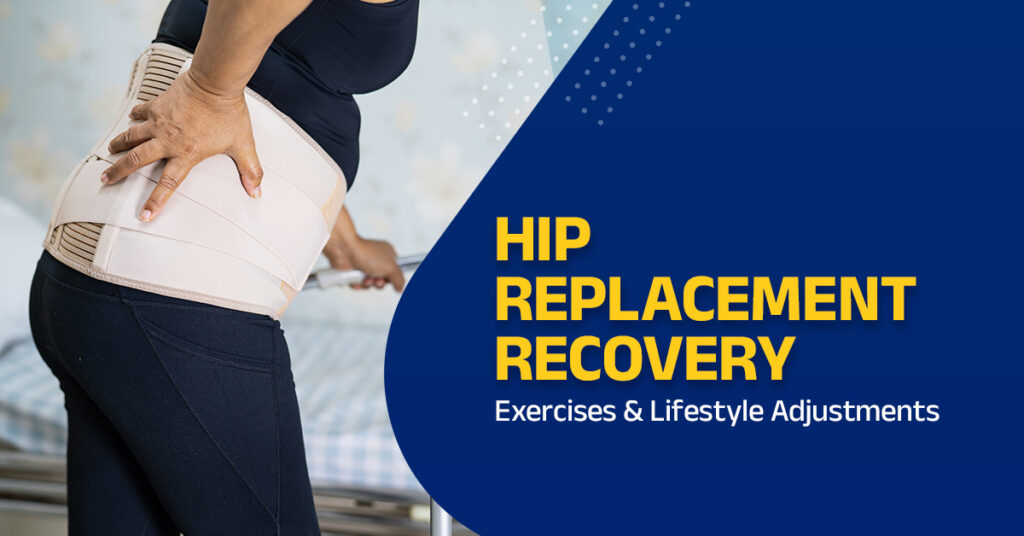Have you ever caught yourself thinking, “I just want to walk without pain again”? For many people, that moment comes after months or even years of hip discomfort that limits daily life whether it’s climbing stairs, sitting cross-legged or enjoying a simple evening walk. Hip replacement surgery is often a life-changing solution, but many patients worry about what comes next: How long will it take to recover? What exercises are safe? When can I get back to normal activities?
The truth is, hip replacement recovery is a journey but one you don’t have to take blindly. With the right exercises, lifestyle modifications and guidance from your doctor, you can make this transition smooth, safe and successful.
Why Recovery Matters as Much as Surgery
Hip replacement surgery replaces the damaged joint with an artificial one but surgery alone isn’t enough to restore full mobility. Your muscles, ligaments and tendons need time and guided movement to regain strength and flexibility. Recovery is not passive,it’s an active process where your effort plays a direct role in how quickly and comfortably you get back to your routine.
The Recovery Timeline: What to Expect
Every patient’s recovery is unique but here’s a general timeline you can use as a guide:
Week 1–2: Early Healing Phase
- Mobility: Most patients begin standing and taking a few steps with a walker within 24–48 hours.
- Goals: Prevent blood clots, manage pain and gently activate muscles.
- Activities:
- Ankle pumps every hour while lying down.
- Short walks around the room several times a day.
- Practicing safe techniques for getting in/out of bed or chairs.
Think of this as “laying the foundation”—you’re getting used to your new joint.
Week 3–6: Regaining Strength
- Mobility: Transition from walker to Independant walking (with your doctor’s approval).
- Goals: Improve range of motion, build muscle strength and reduce stiffness.
- Activities:
- Heel slides, glute squeezes and standing hip extensions.
- Walking for 5–10 minutes, several times a day.
- Light household activities like setting the table or cooking.
Week 7–12: Returning to Daily Life
- Mobility: Most patients can walk without assistive devices and climb stairs.
- Goals: Resume normal activities safely, improve balance and coordination.
- Activities:
- Stationary cycling or water exercises (if incision is healed).
- Balance exercises under supervision.
- Driving and desk work (after doctor approval).
Month 3 and Beyond: Full Recovery
By this stage, most patients return to low-impact activities like swimming, yoga, or gentle trekking. High-impact sports or running should be avoided unless cleared by your doctor.
Essential Exercises for Hip Recovery
Physiotherapy is the backbone of hip replacement recovery. Here are key exercises commonly recommended:
- Ankle Pumps: Flex and point your feet to promote blood circulation.
- Quad Sets: Tighten thigh muscles, hold 5 seconds, and release—10 repetitions.
- Gluteal Squeezes: Tighten buttock muscles to improve hip stability.
- Heel Slides: Slide your heel towards your hips while lying flat to maintain mobility.
- Standing Hip Abductions: Lift your leg slightly sideways while holding onto support to strengthen hip muscles.
Tip: Consistency is key. Doing these exercises several times a day rather than once yields better results.
Lifestyle Adjustments for a Smooth Recovery
Small adjustments in daily habits make recovery easier and safer:
- Modify Your Home: Use a raised toilet seat, install grab bars in the bathroom, and keep essentials within arm’s reach.
- Avoid High-Risk Movements: Don’t cross your legs, sit on very low chairs or twist your body while standing.
- Practice Safe Sleeping: Lie on your back or on the recommended side with a pillow between your knees.
- Eat for Healing: Focus on protein (lean meats, eggs, legumes), calcium-rich foods (milk, curd) and hydration to promote tissue repair and bone health.
- Prioritize Rest: Sleep well to allow your body to recover but avoid prolonged bed rest which can slow progress.
Long-Term Lifestyle After Hip Replacement
Once fully recovered, maintaining hip health becomes important:
- Stay physically active with low-impact activities like cycling, walking and swimming.
- Maintain a healthy weight to avoid stress on the new joint.
- Continue stretching exercises to keep muscles flexible.
- Get regular check-ups to monitor implant health and joint function.
The Role of Expert Guidance
While online resources are helpful, your recovery plan should be personalized based on your age, medical history, and type of surgery. Working with an experienced orthopedic surgeon and physiotherapist ensures that you progress safely and efficiently.
Dr. Saurin Shah, a leading hip replacement doctor in Ahmedabad, is known for adopting the latest minimally invasive techniques and evidence-based recovery protocols. His patient-centric approach focuses on early mobility, faster healing, and long-term joint health.
Final Thoughts
Hip replacement recovery can feel challenging, but with the right approach, it’s an empowering process that helps you reclaim your independence and quality of life. By committing to your exercise routine, making practical lifestyle adjustments and following medical guidance closely, you can look forward to walking, traveling and enjoying life without pain.
If you are planning hip replacement surgery or are in recovery, consult with a trusted specialist who can guide you through a structured and safe rehabilitation journey.
Addressing Common Concerns
Patients often have several questions during recovery, such as:
Will I always feel stiff?
Mild stiffness may last for a few months but gradually improves with exercises and regular walking.
When can I drive again?
Usually after 6–8 weeks, once you can control the leg without pain or hesitation. Always check with your doctor first.
What if I feel pain while exercising?
Mild muscle soreness is normal, but sharp pain, redness, or swelling should be reported immediately.
Having these answers early can reduce anxiety and help you stay motivated throughout your rehabilitation.

